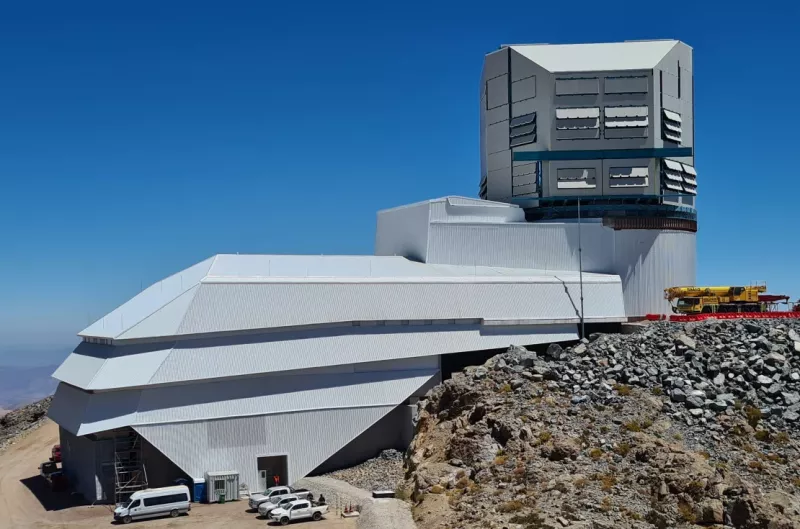Telescope with world’s largest digital camera will be a ‘game-changer’ for astronomy
By: Jacopo Prisco (CNN)


A literal shot in the dark.

On a mountaintop in northern Chile, the world’s largest digital camera is preparing to power up.
Its mission is simple yet ambitious — to photograph the entire night sky in extreme detail and unlock some of the universe’s deepest secrets.
Housed inside the Vera C. Rubin Observatory — a new telescope nearing completion on Cerro Pachón, a 2,682-meter (8,800-feet) tall mountain about 300 miles (482 kilometers) north of the Chilean capital Santiago — the camera has a resolution of 3,200 megapixels, roughly the same number of pixels as 300 cell phones, and each image will cover an area of sky as big as 40 full moons.
Every three nights, the telescope will image the entire visible sky, producing thousands of pictures that will let astronomers see anything that moves or changes brightness. The expectation is that in this way, Vera Rubin will discover about 17 billion stars and 20 billion galaxies that we’ve never seen before — and that’s only the beginning.
“There’s so much that Rubin will do,” says Clare Higgs, the observatory’s astronomy outreach specialist. “We’re exploring the sky in a way that we haven’t before, giving us the ability to answer questions we haven’t even thought to ask.”
The telescope will survey the night sky for exactly a decade, taking 1,000 pictures each night. “In 10 years, we’re going to be talking about new fields of science, new classes of objects, new types of discoveries that I can’t even tell you about now, because I don’t know what they are yet. And I think that’s really an exciting thing,” Higgs adds.
Preparing for switch-on
Under construction since 2015, the telescope is named after pioneering American astronomer Vera Rubin, who died in 2016 and, among other achievements, first confirmed the existence of dark matter — the elusive substance that constitutes the majority of the matter in the universe, but has never been observed.
The project was kickstarted in the early 2000s by private donations, including from billionaires Charles Simonyi and Bill Gates. It was later jointly funded by the Department of Energy’s Office of Science and the US National Science Foundation, which also runs it along with SLAC National Accelerator Laboratory, a research center operated by Stanford University in California.
Although Rubin is a US national observatory, it is in the Chilean Andes, a location it shares with several other telescopes for a number of reasons. “For optical telescopes, you need a site that is high, dark and dry,” says Higgs, referencing the issues of light pollution and air moisture, which reduce the instruments’ sensitivity. “You want a very still and well understood atmosphere, and the quality of the night sky in Chile is exceptional, which is why there’s so many telescopes here,” she adds. “It’s remote, but it’s also not so remote that getting the data off the mountain is a problem — there’s infrastructure that Rubin is able to lean into.”
Currently in the final stages of construction, the telescope is expected to switch on in 2025. “We are currently working on assembling all of the pieces, but they are all there on the mountaintop — that’s a big milestone we reached over the summer,” Higgs says. “We’re expecting things to happen in the spring of next year — getting everything together, everything aligned, making sure all systems, from the summit all the way through our pipelines and the data, are looking as they should and are optimized as best we can. There’s been literal decades of prep work on this, but you never know until you turn everything on.”
After a few months of testing, in late 2025, the observatory will perform its first observations, although Higgs warns that there is “fluidity” in this schedule.
“10 million alerts per night”
Rubin’s main mission is called LSST — for Legacy Survey of Space and Time. “This is a 10-year survey in which we look at the southern sky every night, and we repeat that every three nights. So we basically create a movie of the southern sky for a decade,” Higgs says.
The camera can take a picture every 30 seconds, which will generate 20 terabytes of data every 24 hours, as much as the average person watching Netflix for three years, or listening to Spotify for 50 years. Upon completion, the survey will have produced over 60 million gigabytes of raw data.
However, it will take only 60 seconds to transfer each image from Chile to California, where AI and algorithms will analyze it first, searching for any changes or moving objects, and generating an alert if anything is found.
“We’re anticipating about 10 million alerts per night coming off the telescope,” Higgs says. “The alerts are anything that changes in the sky, and span a whole range of science cases, like solar system objects, asteroids and supernovae. We are anticipating millions of solar system stars and billions of galaxies, which is why machine learning is really essential.”
The data will be released to a select group of astronomers every year, and then after two more years, each data set will be made available publicly, for the global science community to work on, Higgs says.
There are four main areas of research that it is hoped the data will cover: creating an inventory of the solar system — which includes discovering several new celestial bodies and perhaps the hidden planet known as Planet Nine; mapping our entire galaxy; exploring a special category of objects called “transients,” which change position or brightness over time; and understanding the nature of dark matter.
“There are probably 10 different fields of science where I can tell you that Rubin is going to do great,” Higgs says. “I think we’ll get more Type I supernovae in a couple of months than have ever been observed, for example. Interstellar objects, we have two candidates now, but Rubin is going to take that from two to hopefully more than a few.
“There’s so many fields where we’re going to go from a couple of something to a statistically large sample of something, and the science impact of what that can do is huge.”
“Revolutions are afoot”
The astronomical community is very excited about the Vera Rubin Observatory, says David Kaiser, a professor of physics and the Germeshausen professor of the history of science at the Massachusetts Institute of Technology. According to Kaiser, the telescope should help clarify longstanding questions about dark matter and dark energy — two of the most stubborn and mysterious features of our universe.
“The Vera Rubin Observatory will enable astronomers to map the distribution of dark matter like never before, based on how dark matter bends the path of ordinary starlight — a process known as ‘gravitational lensing,’” Kaiser explains. “Dark matter seems to be ubiquitous throughout the universe, but how exactly has it been clumping or clustering over time remains difficult to quantify for large swathes of the night sky,” he says, adding that by gathering more data about the distribution of dark matter, the Vera Rubin Observatory could help astrophysicists discern its properties.
Another long-standing cosmic riddle that Rubin could solve is the hunt for Planet Nine. Konstantin Batygin, a professor of planetary science at the California Institute of Technology, who has written several academic papers on the subject, says the telescope not only “provides a real chance to directly detect Planet Nine, but even if the planet eludes direct observation, the detailed mapping of the dynamical architecture of the outer solar system — particularly the orbital distribution of small bodies — will offer critical tests of the Planet Nine hypothesis.” In short, he adds, the Vera Rubin Observatory is set to revolutionize our understanding of the outer solar system, and is poised to be a “game-changer.”
There are few astronomers who aren’t excited about Rubin, says Kate Pattle, a lecturer in the Department of Physics and Astronomy at University College London, because it will map space on size scales ranging from the most local — tracking near-Earth asteroids in our own Solar System — to the largest, mapping the distribution of dark matter across the universe.
“Rubin will come back to the same parts of the sky again and again, meaning that it will break new ground in the study of astronomical transients — it will identify variable stars, track supernova remnants as they decay, and observe very high-energy gamma ray bursts and the variability of quasars, which are very distant, very active galaxies. By doing so, it will provide unprecedented insight into how our universe and the stars and galaxies within it evolve.”
According to Priyamvada Natarajan, a professor of astronomy and physics at Yale University, the Rubin Observatory stands to break records on many fronts and the entire astronomy community is waiting for “first light.” The survey will provide data for a myriad of science projects that will address many fundamental open questions in one go — ranging from the near to the distant universe, including not just a treasure trove of galaxies, clusters, quasars, supernovae, gamma-ray bursts and other transients — “It will also sharpen our view of the solar system with an as-yet unmatched inventory of near-Earth asteroids, Kuiper belt objects (an area of icy objects beyond the orbit of Neptune) — in short there is something for everyone,” she says.
She adds that the most exciting find would be if the telescope were to reveal the true nature of dark matter — a discovery that would be sure to delight Vera Rubin.
“After all, it was her seminal work on the detection of dark matter in spiral galaxies in the 1970s that got this pursuit going,” says Natarajan. “The prospects are tantalizing — and revolutions are afoot for sure.”




Ten years to construct. Ten years to operate. And no idea what we'll get out of the project. We do know with certainty that this giant digital camera won't solve climate change. Won't address overpopulation. Won't lessen disparities in health, wealth, and prosperity.
But we'll get a whole bunch of pretty pictures. Sometime in the future. Don't know when but it'll happen.
Hopefully they got their SI and English units squared away.